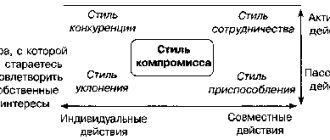The concept of “stress” has become very firmly established in everyday life in recent decades. The term itself refers to emotional dysfunction and tension, which is always accompanied by a negative mood. It came to us from medieval England, where “distress” meant grief or need.
Stress is the body’s ability to adapt to changing living conditions. In the modern rhythm of life, conditions change not only every day, but also every hour. Therefore, we can say with confidence that stressful situations have become commonplace.
By stress we mean a feeling of dissatisfaction, bitterness of loss or seasonal blues, but despite the general symptoms, this phenomenon has several types, subtypes, stages of development and phases. Let's take a closer look at them.
Three stages of stress
G. Selye, a Canadian researcher and doctor, found that every body has the same reaction to stress, based on this pattern, he divided the whole process into 3 phases:
- Anxiety reaction
, in which all the protective functions of the body are mobilized. The body adapts to new conditions of existence. Thanks to the functional integration of organs and vital systems, senses such as memory, attention, touch, and perception are enhanced. The mobilization stage is characterized by the fact that during stress, the degree of thinking increases, options for solving the problem are found, and the person copes with the resulting load. Anxiety stage. - Resistance to imbalance
, when the body adapts to changes, and all parameters that were out of control at stage 1 are normalized. The individual gets used to the new atmosphere, but if it is difficult for the body to quickly adapt, and the resistance continues for a significantly long time, the last phase of stress begins. Resistance stage. - Exhaustion
occurs after unsuccessful attempts at adaptation, when physical strength is lost and the mental state begins to malfunction. This phase is divided into 2 stages.
Selye's stages of stress are clearly illustrated
The exhaustion stage under stress goes through two stages:
- At the stage of the disorder
, there is a decrease in performance, the level of thinking and perception decreases, and it becomes difficult to find a way out of the current circumstances. A person cannot adequately assess the situation and make any decision. This affects the results of work; creative thinking is replaced by simple repetition of action algorithms. If this process affects the management level, then impulsive demands on employees and inappropriate aggressive attacks towards them begin. Exit routes are randomly selected from the list that arose at the first stage of stress. - At the destruction
, all processes are inhibited. The person falls into numbness, it is difficult for him to concentrate on important things, he does not delve into the essence of the conversation, withdraws into himself and is more silent. This type of destruction is called hyperinhibition. This phenomenon can also develop in another “channel”, when a person, unable to find a place for himself, commits rash acts, his activities are disordered. He becomes withdrawn, it is difficult to shout or “reach out” to him. This type of stress is called hyperarousal.
During the exhaustion phase, various diseases appear that affect:
- gastrointestinal tract;
- cardiovascular system;
- mental condition;
- immunity;
- condition of hair, nails and skin.
Why are we stressed?
Stress is a person’s reaction to a situation of threat or sudden change in the situation (external or internal).
Stress reactions are very, very archaic. I’ll tell you a secret, of all the primitive people, only those who knew how to react correctly to danger survived. Therefore, they are built into us as firmly as the principle of survival in the jungle.
The stages of stress are also archaic and have little control over our consciousness - anxious mobilization in the face of a threat, sustained tension of all systems to confront the danger (to flee for salvation or to mobilize for attack) and subsequent depletion of resources.
Stress in the workplace is complicated by the fact that there are many written and unwritten rules and prohibitions that govern behavior in the workplace. For example, it is unlikely that in any company it is encouraged to attack a client or boss with rage. Not everywhere you will be patted on the head for running out of your daily planning meeting with a cry of despair. In most cases, we are required to maintain the company’s reputation and our own at the highest level.
On the other hand, stress is a constant phenomenon, because changes constantly occur to us. Either we are hungry or we have eaten too much. Sometimes it’s too dark for us at night, sometimes it’s too light during the day. Either we are languishing from idleness, waiting for instructions from our superiors, or we are fussing in a panic before the “deadline” for submitting a report.
Here are some stress factors at work:
- Insufficient or excessive illumination of the workplace.
- Crowded or huge spaces.
- Noise or complete silence.
- Distractions and interference.
- Assessment threat.
- Time restrictions.
- Physical and emotional fatigue.
- Anxious waiting (idleness).
- Unpredictability of the situation.
- Psychological pressure from authority or boss.
- Perfectionism or hyper-responsibility.
- Conflicts and misunderstandings in communication with colleagues.
- Sudden failure of equipment, lack of connection or wi-fi.
- Monotony of work operations.
- Toxic employees in a team.
Classification of stress - types and subtypes
The duration of stress is:
- short-term;
- episodic;
- chronic.
Stress is divided into groups depending on the reasons that provoked its occurrence:
- unfulfilled hopes;
- excitement before competitions;
- lost time;
- changes in life;
- monotony of life;
- the emergence of passivity;
- the unattainability of perfection;
- sudden changes;
- satiety with benefits;
- achieving your goals.
Stress depends on many factors that determine the type of emotional stress. These are everyday conflicts, dissatisfaction with life, salary, position, fear of one’s uselessness to society, lack of time, constant change of time zones, hierarchy of relations between employees and management.
There are many reasons and they are divided into 3 groups:
- manageable stressors;
- stressors undergoing attenuation;
- constant stressors.
14 stages of stress development according to Torsunov:
Help from a psychologist for stress
A psychologist’s help with stress can be used in two ways:
- If any new situation is stressful for you. You often experience a state of causeless anxiety, are depressed, irritable, depressed in the absence of objective reasons. For you, there are a large number of stress factors of psychological origin. Stress is not caused by objective reasons, but by your subjective assessment of what is happening, expectation of the worst consequences, etc. In this case, sessions with a psychologist will help change your assessment of what is happening and reduce the amount of stress of psychological origin.
- Neutralizing the effects of stress. Classes with a psychologist in this direction will help if you have already experienced severe stress , your energy reserves have been depleted, and you feel the need to recover. It is also important to work through and understand the emotional causes of the psychosomatic illness that has arisen in order to prevent its further development.
Amber Center specialists have experience in successfully working with the causes and consequences of stress. After a psychological diagnosis, a psychologist (psychotherapist) will develop an individual training route and, if necessary, give exercises for independent work at home.
Make an appointment with a specialist by calling (812) 642-47-02 or fill out the application form on the website.
Light and dark side
We are accustomed to the fact that stress always has negative consequences, called distress, but there is also a positive side to this phenomenon - eustress:
- Distress
is characterized by an imbalance in the physiological and psychological parameters of the body. It can be short-term and quickly reach the “boiling point”, or it can become chronic and entail failures of all vital systems. - Eustress
can be defined by a surge of joyful emotions and a person’s positive attitude. This happens when he knows about an approaching problem situation, does not know how to solve it, but hopes for a successful outcome. For example, an interview for a well-paid position or entrance exams to an educational institution. Such stress is necessary to solve everyday problems that arise, because it mobilizes all forces for a positive outcome. For example, despite the hated ringing of the alarm clock in the morning, it makes you cheer up and wake up. Eustress, although weak in strength, is beneficial to human health and positions itself as an “awakening reaction.”
Subtypes of distress
The most common subtype of distress is physiological stress. It occurs when external factors influence the human body. If you get burned or hungry, overheated in the sun and pinch your finger, then you cannot do without stressful shocks. At the physiological level, stress is divided into several groups:
- biological
is associated with the occurrence of various diseases; - chemical
stress caused by exposure to chemicals, as well as oxygen starvation or excess oxygen); - physical
is provoked by excessive physical exertion, professional athletes are susceptible to it; - mechanical
occurs in the postoperative period, when complex injuries occur that violate the integrity of tissues or organs.
The next subtype is psychological stress, which is characterized by two types of conflict:
- Dissatisfaction with oneself associated with a discrepancy between expectations and reality
. This conflict most often occurs among people who cannot come to terms with age-related changes in appearance and the body as a whole. - Stressful state due to social conflicts within a social unit
. For example, intra-family conflicts, quarrels with friends or colleagues.
Emotional stress occurs when a person is exposed to an emotional stimulus. Conflicts become such irritants when a person cannot satisfy biological or sociocultural needs for a long time.
For example, a strong resentment towards a loved one, deception, as well as information overload, which usually occurs when preparing for exams or submitting annual reports. Over the course of many years of research, it has become clear that stress is individual for each person and leads to different consequences.
Interestingly, people with increased stress tolerance quickly cope with extreme situations. Those whose indicator is underestimated may encounter neuroses, high blood pressure, and disruption of the vital systems of the body. What will suffer the most depends on individual characteristics and the presence of chronic diseases, because the load mainly falls on the weakest link.
Benefits from stress
Exposure to mild stressors is somewhat beneficial. Firstly, mild short-term stress helps to activate resources and mobilize to perform a specific task (for example, to pass an exam). Secondly, with each stress, the psyche appears several new activity programs, that is, a person expands and replenishes his behavioral “repertoire” with new ways of interacting with the outside world, and increases self-confidence with each obstacle overcome. The natural need for renewal of emotions is saturated. It is important that the body has enough reserves to adapt.
Types of people in stressful situations
Each person reacts to sources of stress individually; each phase can last longer or shorter for different people. This depends on a person’s resistance to stress, on his ability to quickly “bend under” the situation and find the right solution to solve the problem.
Experts have found that there are different reactions to stress and have identified 3 types of people:
- those who can withstand stress for a long time
, while being in excellent shape and in an adequate mental state; - those who, when a problem arises, lose their ability to work
, it is difficult for them to find a solution and adapt to new conditions; - those who can work productively and show high results only under stress
, problems “spur them on” and force them to move forward.
Causes of emotional stress
Stress can be caused by both sudden and ongoing negative events in a person’s life. If a tragedy occurs, or, conversely, a person has been a prisoner of a difficult situation for a long time without the opportunity to rest or switch attention from the traumatic situation, a kind of “mental burnout” may occur.
At the same time, the source of serious emotional stress can be both real traumatic events and a person’s excessively negative perception of various, for most people, events that are not something serious. In this case, the risk group will be people with an easily excitable psyche, suspicious, rigid, and unable to switch.
Specific causes of emotional stress for most people:
- death or serious illness of a loved one
- disaster
- war
- job loss
- serious illness
- divorce
- change of residence
- loss of source of income
- breaking up with a loved one











